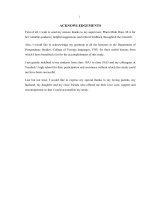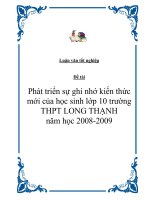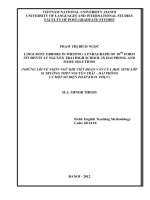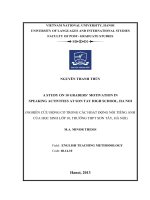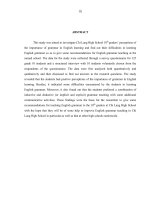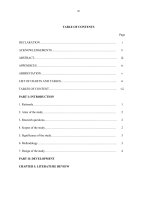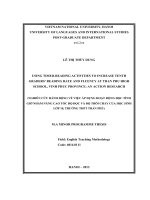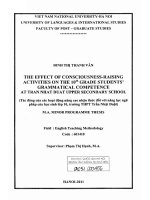Tác động của các hoạt động nâng cao nhận thức đối với năng lực ngữ pháp của học sinh lớp 10, trường THPT Trần Nhật Duật t
Bạn đang xem bản rút gọn của tài liệu. Xem và tải ngay bản đầy đủ của tài liệu tại đây (1.6 MB, 59 trang )
vii
TABLE OF CONTENTS
Page
DECLARATION …………………………………………………………………
i
ACKNOWLEDGEMENTS…………………………………………………………
ii
ABSTRACT…………………………………………………………………………
iii
APPENDICES………………………………………………………………………
iv
ABBREVIATION…………………………………………………………………
v
LIST OF CHARTS AND TABLES………………………………………………
vi
TABLES OF CONTENT……………………………………………………………
vii
PART I: INTRODUCTION
1. Rationale………………………………………………………………………….
1
2. Aims of the study…………………………………………………………………
2
3. Research questions………………………………………………………………
2
4. Scopes of the study……………………………………………………………….
2
5. Significance of the study…………………………………………………………
3
6. Methodology……………………………………………………………………
3
7. Design of the study……………………………………………………………….
4
PART II: DEVELOPMENT
CHAPTER I: LITERATURE REVIEW
viii
1.1 Theoretical background of task based approach………………………………
5
1.1.1 Definition of tasks……………………………………………………………
5
1.1.2 Types of tasks within Task-based language teaching ……………………………
7
1.1.3 The principles of Task-based language teaching…………………………………
8
1.1.4 The role of teacher and learner in Task-based language teaching…………….
9
1.1.5 The performance of task……………………………………………………………
10
1.2 Theoretical background of writing skills……………………………………….
12
1.2.1 Definitions and roles of writing…………………………………………………….
12
1.2.2 Types of writing………………………………………………………………………
14
1.2.3 Approaches of teaching writing skills……………………………………………
14
1.2.4 Marking scheme of test………………………………………………………………
16
CHAPTER II: METHODOLOGY
2.1 Setting of the study……………………………………………………………
21
2.2 Subjects………………………………………………………………………….
23
2.3 Data collection…………………………………………………………………
23
2.3.1 Questionnaire …………………………………………………………………………
23
2.3.2 Pre test………………………………………………………………………………….
23
2.3.3 Post test………………………………………………………………………………
24
2.3.4 Interview………………………………………………………………………………
24
ix
CHAPTER III: DATA PRESENTATION, ANALYSIS AND DISCUSSION
3.1 Data analysis……………………………………………………………………
25
3.1.1 Data analysis of students’ and teachers’ survey questionnaire………………
25
3.1.1.1 Data analysis of students’ survey questionnaire………………………………
25
3.1.1.2 Data analysis of teachers’ survey questionnaire………………………………
30
3.1.2 Data analysis of students and teachers’ direct interview……………………….
34
3.1.2.1 Data analysis of the interview for the students………………………………
34
3.1.2.2 Data analysis of the interview for the teachers………………………………
35
3.1.3 Data analysis of pre and post tests………………………………………………
36
3.2 Findings ……………………………………………………………………….
38
3.3 Suggested techniques for application of the task based approach to improve 8
th
graders’ writing skills
41
3.3.1 3.3.1 Suggestions for the teachers…………………………………………………………
41
3.3.2 Suggested techniques to motivate students’ writing…………………………….
41
3.3.2.1 Extra tasks…………………………………………………………………………
41
3.3.2.2 Group work…………………………………………………………………………
42
3.3.2.3 Using games………………………………………………………………………
42
PART III: CONCLUSION
4.1 Summary of the study………………………………………………………….
43
x
4.2 Limitation and suggestion(s) for further research………………………………
44
4.2.1 Limitation of the research……………………………………………………………
44
4.2.2 Suggestions for further research……………………………………………………
44
REFERENCES
45
APPENDIX
1
PART I. INTRODUCTION
1. Rationale
The general goal of teaching a foreign language is to train students‟ communicative
abilities. English writing is one of the most communicative abilities among others such as
listening, speaking and reading and it is also one of the most difficult skills that students get
at school. According to David Nunan (1979:35) “Writing can be a tough activity for
students, even though the writing activity is in their first language. Learning to write
fluently and expressively is the most difficult of the four macro skills for all language users
regardless of whether the language in question is a first, second or foreign language”.
There appear many reasons why students are encountering too much difficulty in writing
something in English such as the inappropriate teaching methodology, students‟ low
motivation on learning English, and limited time of teaching and learning process. Among
these factors, teaching methodology is considered as the most manageable one to be studied
influencing directly students‟ writing difficulties since motivation is difficult to measure
and time is a fixed factor. The boring and repetitive teaching method can‟t arouse students‟
interest in writing English.
One of the other reasons I decided to study this thesis is the fact that students graded 8 are
considered as the first class to begin learning how to write long texts related to real contexts
with a little control. They are asked to write an invitation and replies, a process, an event
happened in the past, a brief personal letter and so on. These situations often happen in
daily life. However, due to lack of vocabulary and new structures, students make many
mistakes in spelling, punctuation, grammar. Generally their common errors focus on syntax
and semantics. Because lesson time is limited and class size is large, teachers can not cover
all the students‟ mistakes. Students are given much control before writing but less guide or
help from teachers after their writing. As a result, mistakes repeat again and again
whenever students write. Whereas many other students pay a little attention to writing, or
even no interest in it. Therefore their writing skill is hardly improved.
At present many approaches are being applied in teaching writing skill such as genre based
2
approach, process based approach ect… At the secondary school, these approaches are
combined. However in this study I chose the task based approach as the best to improve
writing to the 8
th
students at Quang Vinh secondary school which is recognized to be able
to adapt this approach. Task based approach has been widely used since the 1980s,
emphasizing “learning while doing” and regards students themselves as the center of
teaching. Writing lessons in the textbook 8 are mainly based on the tasks, but teaching
methods doesn‟t bring effectiveness. On contrary, it causes students tiredness, boredom and
laziness when learning writing skill. The author carried out an action research on the
subjects of 8
th
students at Quang Vinh secondary school to find out how effective this
approach can bring. After a two- week period of practice, students‟ writing is significantly
improved and they become more interested in writing class as well as have more
confidence in writing something in English.
2. Aims of the study
The study is expected to get the following aims:
– - to find out the difficulties in the learning of writing skills that are facing 8
th
graded
students and teachers at Quang Vinh secondary school after 3 first writing lessons?.
– - to explore how the task based language teaching is implemented in classroom to
improve the 8
th
graded students‟ writing.
3. Research questions
To achieve the above aims, the following questions should be answered in the study:
- What are the difficulties in teaching and learning the writing skills of teachers and 8
th
graded students at Quang Vinh secondary school after 3 first writing lessons?
- What is the current teaching method applied to teaching writing skills for the 8
th
grader
after 3 first lessons in Quang Vinh secondary school?
- - What is the effectiveness of application of task based approach in teaching writing
skills to 8
th
graders at Quang Vinh secondary school?.
These research questions served as a guide in the findings of the study.
4. Scopes of the study
The study was conducted to investigate the application of the task based approach in
teaching writing skill to 8
th
graded students at Quang Vinh secondary. So, first of all the
author tried to find out the difficulties of 8
th
students in studying writing skill as well as the
3
current teaching methods implemented there. However, the study can‟t cover all difficulties
due to its diversity; it focuses on the students‟ difficulties in learning writing skill and the
ones related to teachers‟ teaching methods. The author doesn‟t also go into deeply all
approaches being implemented in classroom to teaching the writing, instead she focuses on
the task based language teaching and how it is performed to improve 8
th
graded students
writing skill at Quang Vinh secondary school.
To cover the scopes of the study, a survey questionnaire was distributed to the number of
120 8
th
- graded students selected randomly from three classes and 3 English teachers,
aiming to collect their difficulties, opinion, attitude and suggestions on learning to write
English. Moreover, an interview is also conducted with the participation of 9 students
selected upon their result of post- test and one, those who helped to observe the class to
investigate what the author has actually done during the program. The practice of task
based writing teaching was done on during two weeks.
5. Significance of the study
Firstly, the study was conducted to investigate how the task based language teaching has
effect on the 8
th
students‟ writing skills. Through action research applying the task based
approach, student‟s writing skills at the Quang Vinh secondary school improve after the
program.
Secondly, the study matches the modern approaches to language learning with the
application of the task based approach. The study will be the first in finding out some
activities to support the tasks in the English textbook 8 at the Quang Vinh secondary
school.
6. Methodology
The study was designed to use an action reseach which the collection and analysis of data
related to the author‟s teaching practice. According to Michael J. Wallace the aim of the
action research is “not to turn the teacher into a researcher, but to help him or her to
continue to develop as a teacher, using action research as a tool in this process” (p.18).
Firstly, the author observed the class to see the problem during first three weeks. Then,
based on books, journals, newspapers and some sources on the internet she read, the author
carried out the collection of the data and practicing her teaching. Finally, she summerized
4
some findings and gave suggestions to make full use of the task based approach in teaching
writing skills to the 8
th
graders at Quang Vinh secondary school. Two methods used to
collect the data are qualitative and quantitative.
The qualitative method was used to get information about students‟ opinions, attitude to
learning and teaching writing skills (before and after the task based language teaching was
implemented) including: questionnaire and interview. The data then was interpreted and
analyzed.
The quantitative method was used to evaluate the students‟ level in writing English
including pre and post tests. Both are non-controlling writing that means; free writing
which asked students to write a short composition about a given topic in limited time of 20
minutes.
7. Design of the study
The study consists of three main parts:
- The introduction gives the background, the limitation of thesis, the research method, and
the significance of the study. This part helps provide a general knowledge about the study.
- The development is divided into three chapters numbered from one to three. Chapter one
provides the theoretical background as well as the most general review of previous
researches. In other words, it gives the foundation for deeper and broader insight into the
topic in consideration. Chapter two provides the information of the study context. It
includes the reality of teaching and studying English writing skills in Quang Vinh
secondary school, teachers and students and the writing lessons which were taught based
on tasks. Chapter three deals with some findings and gives some recommendations to make
writing teaching better.
- The last part “conclusion” summarizes the main points studied in the thesis and
emphasizes some suggestions for further research.
5
PART II. DEVELOPMENT
CHAPTER I: LITERATURE REVIEW
1.1 Theoretical background of task based approach
1.1.1 Definition of tasks
The term “task” appeared since the twentieth century. Since its birth until now, there exist
a lot of different definitions about “task”. Brabhu, an Indian linguist, is the first person who
raised the definition of “task”. He defines a task as "an activity which required learners to
arrive at an outcome from given information through some process of thought, and which
allowed teachers to control and regulate that process" (p.24). In the other word, tasks are
carried out as a result of processing and understanding language like a response in which
teachers play role in introducing a variety of tasks, evaluating to what extent their students
complete them.
Whereas Nunan (1989) defines a task as “a piece of classroom work which involves
learners in comprehending, manipulating, producing or interacting in the target language
while their attention is principally focused on meaning rather than form" (p.10). In his
opinion tasks is the outcome of the process to understand, solve the problem and use
language for communicative purpose. It is the completeness with focusing on meaning
rather than form. It means that meaning is paid more attedtion to; however it cannot be
separated from form. In contrast, meaning always goes with form to express
communicative ideas, thought and attitude.
According to Willis (1996) “tasks are always activities where the target language is used
by the learner for a communicative purpose (goal) in order to achieve an outcome” (p.23).
She gave her view that “the aim of tasks is to create a repurpose for language use and to
provide a natural context for language study" (p.1). However, she didn‟t yet clarify that
task can be any communicative activities, of any various kinds available in the textbook
and practiced in the classroom.
Skehan (1998:95) highlighted four basic features of tasks. He wrote that task is "an activity
in which: meaning is primary; there is some communication problem to solve; there is
6
some sort of relationship to comparable real world activities; task completion has some
priority; and the assessment of task performance is in terms of task outcome".
Another definition is that “a task is a device that guides learners to engage in certain types
of information-processing that are believed to be important for effective language use
and/or for language acquisition from some theoretical standpoint” (Ellis, 2000, p.197). It
means that learners use the linguistic knowledge to communicate effectively through the
information processing. Like other language activities, a task can engage productive or
receptive, and oral or written skills.
While the above definitions of the task are different in some way, they all emphasize that
task in classrom is the use of second language in term of communicative view, in which
focuses more on meaning than grammatical form. In other words, learners are free to use
whatever language they want to convey their intended meaning and maintain interaction. It
is applied in all skills for learning a target language with a variety of real world situations
and in the end it brings about an outcome through the exchange of meanings presented or
reported by learners …
1.1.2 Types of tasks within Task-based language teaching
Ellis (2003) classified tasks into the following types:
a. Unfocused Tasks
An unfocused task is one that encourages learners to use English freely without
concentrating on just one or two specific forms (i.e., a replication activity).
b. Pedagogic (rehearsal, activation)
Pedagogical tasks are the tasks which occur in classroom rather than outside the world.
Pedagogic tasks can be:
Rehearsal tasks
Example:
You are an airline employee. Use the information sheet (provided separately) to answer
your partner's questions.
Activation tasks
7
The teacher gives pairs of student two different pictures, and then asks each one to talk to
their partner about the differences between the pictures.
Real-world tasks
Tasks are everywhere in everyday life. Washing our face is a task, as is preparing
breakfast, going to work by car, etc. Tasks are a part of our lives to such an extent that
there is hardly any activity that cannot be called a task.
c. Focused Tasks
A focused task is a consciousness-raising activity that focuses on examining samples of
language to explore particular features. These are sometimes called "meta-cognitive"
activities. Examples of this are classifying the uses of a verb plus – "ing" forms that appear
in a reading text or identifying phrases from a spoken transcript containing the preposition
in and categorizing them into time, location, or other, or a task used because it is likely to
encourage the comprehension of, and/or the use of, particular language forms.
Unlike Ellis, Willis (1996: 149) listed the following types of tasks of TBLT:
1. Listing: Including a brainstorming and fact-finding, the outcome is a completed list or
draft mind map. This type of task can help train students' comprehension and induction
ability.
2. Ordering, sorting: Including sequencing, ranking and classifying, the outcome is a set
of information ordered and sorted according to specific criteria. These types might foster
comprehension, logic and reasoning ability.
3. Comparing: This type of task includes matching, finding similarities, or differences.
The outcome can be appropriately matched or assembled items. This type of task enhances
students' ability of differentiation.
4. Problem solving: This type of task includes analyzing real situations, reasoning, and
decision-making. The outcome involves solutions to the problem, which can then be
evaluated. These tasks help promote students' reasoning and decision-making abilities.
5. Sharing experience: These types of tasks include narrating, describing, exploring and
explaining attitudes, opinions, and reactions. The outcome is usually social. These tasks
help students to share and exchange their knowledge and experience.
6. Creative tasks: These include brainstorming, fact finding, ordering and sorting,
comparing and many other activities. The outcome is an end product that can be
8
appreciated by a wider audience. Students cultivate their comprehensive problem-solving
abilities as well as their reasoning and analyzing abilities.
These tasks are listed from easy to difficult, and all of them reveal the recognition process
of students. The tasks in TBLT should be applicable to real life to help students accomplish
the tasks and show their communicative competence in classroom teaching and real life
situations (Willis, 1996: 149).
1.1.3 The principles of Task-based language teaching (TBLT)
Ellis (2003) stated that task based language teaching is considered as a form to treat
language as tool to communicate rather than a subject for study. It is the fact that if learners
want to develop their competence, they need to use a target language easily and effectively
in all situations outside the class. They need to see and experience how language used in
real world. For this reason, tasks are served as the most effective means to organize
teaching in line with the lines.
TBLT is based on a theory of language learning rather than a theory of language structure.
Richards and Rodgers (2001: 228) suggest that because the reason for this is that "tasks are
believed to foster processes of negotiation, modification, rephrasing, and experimentation
that are at the heart of second language learning".
Whereas, according to Shehadeh (2005), the use of tasks as a central component in
language classroom because it provides better contexts for activating learner acquisition
processes and promoting L2 learning.
Feez (1998: 17) summarizes the following basic assumptions of TBLT:
- The focus of instruction is on process rather than product.
- Basic elements are purposeful activities and tasks that emphasize communication and
meaning.
- Learners learn language by interacting communicatively and purposefully while engaged
in meaningful activities and tasks.
- Activities and tasks can be either those that learners might need to achieve in real life, or
those that have a pedagogical purpose specific to the classroom.
- Activities and tasks of a task-based syllabus can be sequenced according to difficulty.
9
- The difficulty of a task depends on a range of factors including the previous experience
of the learner, the complexity of the tasks, and the degree of support available. (Richards
and Rodgers, 2001: 224).
Breen (1987a) considers that the TBA is a result of
i) New views on language.
ii) New views on teaching methodology.
iii) New views on the contribution of the learners to the learning process.
iv) New views on how to plan teaching and learning.
1.1.4 The role of teacher and learner in Task-based language teaching
According to Willis (1996), the teachers and learners play different roles for the framework
in the task based language learning.
Teacher’s roles
In the pre-task, the teacher should:
- Present and define the topic.
- Use activities to help students memorize/learn some useful words and phrases.
- Ensure that students comprehend the task instructions.
- Play recordings of others performing the same task or a similar one
In the task cycle, the teacher should:
- Act as monitor and motivate students.
- Ensure that the purpose of the report is clear.
- Act as a language advisor.
- Help students review oral reports.
- Act as chairperson; selecting who will speak next
- Offer brief feedback on content and form.
- Play a recording of others doing the same or similar task.
In the post-task (language focus), the teacher should:
- Review each analysis activity with the whole class.
- Bring other useful words, phrases and patterns to students' attention.
- Review language items from the report stage.
- Conduct practice activities after analysis activities where necessary, to build confidence.
10
Students' Role
In the pre-task, students should:
- Write down useful words and phrases from the pre-task activities and/or the recording.
- Spend a few minutes preparing for the task individually.
In the task cycle, the students should:
- Perform the task in pairs or small groups.
- Prepare to report how they performed the task and what they discovered to the class.
- Rehearse what they will present to the entire class.
- Present their spoken reports to the class.
In the post-task (language focus), the student should:
- Perform consciousness-raising activities to identify and process specific language
features from the task and transcript.
- Ask about other features they noticed.
- Practice words, phrases and patterns from the analysis activities.
- Enter useful language items in their language notebooks.
1.1.5 The performance of task
There are various views on the stages or components of a lesson in which task is applied in
the language. However, all of them have in common three principal phases. These phases
reflect the chronology of a task-based lesson. The first phase is 'pre-task' and concerns the
various activities that teachers and students can undertake before they start the task. The
second phase, the 'during task' phase or “task cycle”, focuses on the task itself and involves
activities that teachers and students can do under certain time. The final 'post-task' phase is
following-up procedures on the task performance.
The pre-task phase
The purpose of the pre-task phase is to prepare students to perform the task in ways that
will promote acquisition. Skehan (1996) refers to two broad alternatives available to the
teacher during the pre-task phase: An emphasis on the general cognitive demands for task,
and/or an emphasis on linguistic factors, then engaging in activities which reduce cognitive
load will release attentional capacity for the learner to concentrate more on linguistic
factors. These alternatives can be tackled procedurally in one of four ways:
(1) Supporting learners in performing a task similar to the task that will perform in the
during task phase of the lesson.
11
(2) Asking students to observe a model of how to perform a task.
(3) Engaging learners in non-task activities designed to prepare them to perform the task
(4) Strategic planning of the main task performance. Performing a similar task.
The use of a 'pre-task' is a key feature of the Communicational Teaching Project (Prabhu,
1987). It was carried out as an activity involving the entire class with the teacher, and
involved the learners in completing a task of the same type and content as the main task.
Thus, it served as a preparation for performing the main task individually.
The task cycle
Richards and Rodgers (2001) asserted that the task is undertaken by students (in pairs or
groups) and gives students a chance to express themselves and write whatever they want to
write. The teacher should move around the classroom and monitor students‟ activities,
encouraging everyone's attempts at communication in the target language. Moreover, the
teacher should help students to formulate what they want to write, but not intervene to
correct errors. Success in achieving the goals of task increases students' motivation. There
are three components of a task cycle:
a. Task
Learners use whatever language they can master, working simultaneously, in pairs or small
groups to achieve goals of the task.
b. Planning
- Planning prepares students for the next stage, when they are asked to report briefly to the
whole class how they performed the task and what the outcome was.
- Students draft and rehearse what they want to say or write.
- The teacher circulates among the students; offering them advice about language,
suggesting phrases and helping them polish and correct their language.
- Emphasis is placed on clarity, organization, and accuracy, as appropriate for an open
representation.
- Individual students often take the opportunity to ask questions about specific language
items.
c. Report
- The teacher asks some pairs or groups of students to report briefly to the entire class so
that every student can compare findings, or begin a survey.
12
- The teacher runs the discussion, comments on the content of the students' reports,
rephrase, but does not make corrections in public.
Post-task
- The students listen to an authentic recording of fluent speakers performing the same task,
and compare it to the ways in which they performed the task.
1.2 Theoretical background of writing skills
1.2.1 Definitions and roles of writing
Over many years ago, human beings used the different forms of writing to record history
and communicate various types of information. At that time, the earliest and simplest form
of writing was the pictogram which was used to communicate about crops and taxes. Then,
the signs developed into the scripts when the society outgrew the power of man‟s memory.
Writing became a reliable means to transfer information, maintain financial accounts, keep
historical records, and similar activities. It is not completely “art of forming graphic symbols”
(Byrne, 1988). That is far more complicated process than the production of graphic
symbols. It is “a process of transforming the material discovered by research inspiration,
accident, trial and error, or whatever into a message with a definite meaning writing is a
process of deliberate decision” (Lannon, 1989: 9). In fact, “writing is far from being a
simple matter of transcribing language into written symbols: it is a thinking process in its
own right. It demands conscious intellectual effort, which usually has to be sustained over
a considerable period of time.” (White & Arndt, 1991:3). This is totally true in the sense it
naturally, but all people have to be taught how to write and it takes much time to acquire.
Writing is also defined as a complex process which involves a number of separate skills
“from the basics of handwriting and spelling to the subtler nuances of tone and
organization.” Therefore, the essence of writing is choice and writing is also considered the
means to communicate in a way that is “profound, or funny, or provocative, or highly
persuasive” (Veit, Gould & Clifford, 2001).
Actually, it is not simple that writing is to put letters, symbols, numbers or words on the
paper or computer screen to express or explain ideas. According to Candlin and Hyland
(1999: 107), “writing is also defined as a social process”. They stated “Writing is therefore
an engagement in a social process, where the production of texts reflects methodologies,
13
arguments and rhetorical strategies constructed to engage colleagues and persuade them of
the claims that are made.”
However, writing, in language teachers‟ opinions, is “a language skill which is difficult to
acquire” (Tribble, 1996: 3). It is “a process that occurs over a period of time, particularly if
we take into account the sometimes extended periods of thinking that precede creating an
initial draft” (Harris, 1993: 10). Tribble also stressed that writing “normally requires some
form of instruction” and that “it is not a skill that is readily picked up by exposure” (1996:
11).
When making a piece of writing, writer implies a message or a certain purpose. In modern
world, writing serves some following functions:
1. Primarily for action: public signs, e.g. on roads and stations; product labels and
instructions, e.g. on food, tools or toy purchased; recipes; maps; television and radio
guides; bills; menus; telephone directories, etc.
For social contact: personal correspondence; letters, postcards; greeting cards.
2. Primarily for information: newspapers and magazines, non-fiction books including
textbooks; public notices; advertisement; guidebooks and travel literature, etc.
3. Primarily for entertainment: light magazines, comic strips; fiction books; poetry and
drama; film subtitles; games including computer games.
(Nunan, 1991:84)
In summary, writing is the expression of language in the letter, words, numbers or
symbols. The primary purpose is to communicate between a person or a group of people
and audiences/readers by a variety of ways such as letters, postcards, books, public notices,
advertisement and so on…Man is not born to have the ability of writing. Writing needs to
be taught through a period of time patiently and carefully. Through the mastery of writing,
writer will become more effective in intellectual organization, in the expression of ideas,
thought and attitudes, in the solution of problems.
14
1.2.2 Types of writing
- Journal/Personal writing
Something that a person writes in everyday such as personal thoughts, ideas, attitudes…
- Descriptive writing
Descriptive writing, sometimes called "showing writing" is writing that describes a
particular person, place or event in great detail. Descriptive writing uses a lot of flowery
adjectives and adverbs to describe what is going on or how something appears.
- Functional writing
Writing that a person has to do in your daily life, like filling out forms, writing a note or
grocery list.
- Expository writing
Expository writing means to inform the reader(s) about something
- Research report
A writer must write research information and often tells about a specific topic
- Narrative writing
A writer tells a story, has a plot, characters, setting, and theme.
- Persuasive writing
The goal is to try and convince people to agree with the writer.
- Informative writing
It is used when a writer are telling facts to someone who doesn't know a lot about his/her
topic.
1.2.3 Approaches of teaching writing skills
First of all, it is the introduction of product approach. According to Pinsca (1982b),
“writing is considered as being primarily about linguistic knowledge, with attention
focused on the appropriate use of vocabulary, syntax, and cohesive devices. In this
approach, learning to write has four stages: familiarization; controlled writing; guided
writing; and free writing. The familiarization stage aims to make learners aware of certain
features of a particular text. In the controlled and guided writing sections, the learners
practice the skills with increasing freedom until they are ready for the free writing section,
when they „use the writing skill as part of a genuine activity such as a letter, story or essay‟
(1982a: 22). In short, the most important thing is the outcome that means, a piece of writing
15
or the product that student produce in target language using their linguistic knowledge.
In process approach, the teaching of writing has begun to move from the concentration on
written products to the emphasis on the process of writing. In this approach, writing is to do
with language skills such planning, drafting, not focusing much on linguistic knowledge
such grammar or text structure. It concentrates on writing as a recursive process in which
writers have the opportunity to plan, draft, edit, and revise their work (Hillocks, 1987;
Murray, 1982). The writer is taught to review and revise several drafts, which enables and
encourages new ideas. Grammatical changes and conventional editing occur during the
revision or editing stage (Ballator, Farnum, & Kaplan, 1999; Flower & Hayes, 1981).
Students to produce a piece of writing often go through four stages: prewriting;
composing/drafting; revising; and editing (Tribble 1996: 39).
The recent approach is the writing based on genre. It can be regarded as the extension of
product approach. The genre-based approach is based on a systemic functional theory of
language developed by Halliday (1978, 1994), and elaborated by Martin (1992), Christie
(1999) and Macken-Horarik (2001) among others. The goals and objectives of genre-based
approach are to enable learners to use genres which are important for them to be able to
participate in, and have access to. The view of language that underlies a genre-based
approach is that language is functional; that is, it is through language that things got done
and certain goals are achieved. Writers, thus, use particular genres in order to fulfill certain
social functions and to achieve certain goals within particular social and cultural contexts.
It emphasizes the various kinds of writing or genres such as: articles, reports, letters…
Each genre has different ways or forms to write… According to Painter (1986) The
learning-teaching cycle, involves three stages:
- Modelling a text
- Joint construction of a text
- independent construction of a text
Teaching can start at any one of these stages, and whichever stage is introduced first the
teacher should offer maximum assistance to the students. The aim is that there is a shift of
responsibility from teacher support to learners taking responsibility for their own learning.
In our case where students were learning a foreign language we tended to offer greater
16
support in the modelling of a text and joint construction. These two stages were repeated a
number of times using a range of texts and tasks incorporating activities which modelled
the target genre.
The task based approach in teaching writing skills is said to be a combination of the above
approaches among other skills despite its identity. Wheas many scholars consider the task
as the process of using target language for communicative purpose, in this case
communication via written form, the task should be the sense of completeness with the
stages the beginning, middle and the end. The writing product is reported in public,
corrected and compared vv…To understand the task, the requirement of task should also be
comprehended, and it means that language learners need to master the writing genres
throught models and instruction of controlled writing. In spite of this similiaries, the task
based approach has its characteristics. It is the process of completing a task in limited time
in which learners are free to use language knowledge serving for communicative purpose.
Its outcome is the result of cooperating in pairs, in groups with certain product reported in
post task stage.
1.2.4 Marking scheme of test
The marking criteria is based on the one used in IELTS exam (International English
Language Testing System), which is the world‟s proven English test.
Task Achievement
Coherence and
Cohesion
Lexical Resource
Grammatical
Range and
9
Fully satisfies all
the requirements
of the task.
Clearly presents
a fully developed
response.
Uses cohesion in
such a way that it
attracts no
attention
Skillfully manages
paragraphing
Uses a wide range
of vocabulary with
very natural and
sophisticated
control of lexical
features; rare
minor errors occur
only as „slips‟
Uses a wide range
of structures with
full flexibility and
accuracy; rare
minor errors occur
only as „slips‟
8
Covers all
requirements of the
Sequences
information and
Uses a wide
range of
Uses a wide range
of structures
17
task sufficiently
ideas logically
manages all
aspects of cohesion
well
Uses paragraphing
sufficiently and
appropriately
vocabulary
fluently and
flexibly to convey
precise meanings
Skilfully uses
uncommon lexical
items but there
may be occasional
inaccuracies in
word choice and
collocation
The majority of
sentences are error-
free
Makes only very
occasional errors or
inappropriacies
7
Covers the
requirements of the
task
Clearly presents
and highlights key
features / bullet
points but could be
more fully extended
Logically organises
information and
ideas; there is clear
progression
throughout
Uses a range of
cohesive devices
appropriately
although there may
be some under-/over-
use
Uses a sufficient
range of
vocabulary to
allow some
flexibility and
precision
Uses less
common lexical
items with some
awareness of style
and collocation
May produce
occasional errors
in word choice,
spelling and/or
word formation
Uses a variety of
complex structures
produces frequent
error-free sentences
Has good control
of grammar and
punctuation but
may make a few
errors.
18
6
Addresses the
requirements of
the task
Presents a purpose
that is generally
clear; there may be
inconsistencies in
tone
Presents and
adequately
highlights key
features / bullet
points but details
may be irrelevant,
inappropriate or
inaccurate
Arranges
information and
ideas coherently
and there is a clear
overall
progression
uses cohesive
devices
effectively, but
cohesion within
and/or between
sentences may be
faulty or
mechanical
May not always
use referencing
clearly or
appropriately
Uses an
adequate range of
vocabulary for the
task
Attempts to
use less common
vocabulary but
with some
inaccuracy
Makes some
errors in spelling
and/or word
formation, but
they do not
impede
communication
Uses a mix of
simple and complex
sentence forms
Makes some
errors in grammar
and punctuation but
they rarely reduce
communication
5
Generally
addresses the task;
the format may be
inappropriate in
places
May present a
purpose for the
letter that is unclear
at times; the tone
may be variable
and sometimes
inappropriate
Presents
information with
some organisation
but there may be a
lack of overall
progression
Makes inadequate,
inaccurate or over-
use of cohesive
devices
May be repetitive
because of lack of
Uses a limited
range of
vocabulary, but
this is minimally
adequate for the
task.
May make
noticeable errors in
spelling and/or
word formation
that may cause
some difficulty for
Uses only a limited
range of structures
Attempts complex
sentences but these
tend to be less
accurate than
simple sentences
May make
frequent
grammatical errors
and punctuation may
be faulty; errors can
19
Presents, but
inadequately
covers, key features
/ bullet points; there
may be a tendency
to focus on details
referencing and
substitution
the reader
cause some difficulty
for the reader
4
Attempts to
address the task but
does not cover all
key features / bullet
points; the format
may be
inappropriate
Fails to clearly
explain the purpose
of the letter; the
tone may be
inappropriate
Parts may be
unclear, irrelevant,
repetitive or
inaccurate
Presents
information and
ideas but these are
not arranged
coherently and there
is no clear
progression in the
response
Uses some basic
cohesive devices
but these may be
inaccurate or
repetitive
Uses only
basic vocabulary
which may be
used repetitively
or which may be
inappropriate for
the task
Has limited
control of word
formation and/or
spelling;
Errors may
cause strain for
the reader
Uses only a very
limited range of
structures with only
rare use of
subordinate clauses
Some structures
are accurate but
errors predominate,
and punctuation is
often faulty.
3
Fails to address
the task, which may
have been
completely
misunderstood
Presents limited
ideas which may be
Does not organize
ideas logically
May use a very
limited range of
cohesive devices,
and those used may
not indicate a
Uses only a
very limited range
of words and
expressions with
very limited
control of word
formation and/or
Attempts sentence
forms but errors in
grammar and
punctuation
predominate and
distort the meaning
20
largely
irrelevant/repetitive
logical relationship
between ideas
spelling.
2
Answer is
barely related to the
task
Has very little
control of
organizational
features
Uses an
extremely limited
range of
vocabulary;
essentially no
control of word
formation and/or
spelling
Cannot use sentence
forms except in
memorized phrases
1
Answer is
completely
unrelated to the task
Not communicate
any message
Can only use a
few isolated words
Cannot use
sentence forms at
all
Table 1: Marking scheme of test
CHAPTER II: METHODOLOGY
21
2.1 Setting of the study
The study was carried out at Quang Vinh secondary school in Thanh Hoa where the
author spent a half of year teaching here as a temporary teacher. The school is located
near the beach in the East of Thanh Hoa Province. It is a small school with 20 rooms.
English is one of the compulsory subjects for all students in the school. The students
here start to learn English at the beginning of grade 6. So English is a new subject at
the secondary school for most students. The majority of them are weak at all skills.
English for the 8
th
graders is learnt during two semesters, divided into105 class hours
including units, reviews and tests. The first semester has 54 periods and 51 left for the
second one. 8
th
graders will have 3 periods of English per week. There are 16 writing
lessons in the English textbook 8, including:
No.
Unit
Lesson
Class
hour
Contents
1
Unit 1: My friends
6
1
- Write about oneself and
about other people
2
Unit 2: Make arrangements
11
1
- Write a message
3
Unit 3: At home
16
1
- Write a description of a
room
4
Unit 4: Our past
25
1
- Write a short imaginary
story
5
Unit 5: Study habits
29
1
- Write a letter to a friend
6
Unit 6: The young pioneers
club
34
1
- Write a letter telling
about a future plan
7
Unit 7: My neighborhood
43
1
- Write a community
notice
8
Unit 8: Country life and city
life
47
1
- Write a letter to a friend
9
Unit 9: A first- aid course
58
1
- Write a thank- you note
10
Unit 10: Recycling
63
1
- Write a set of
instructions
